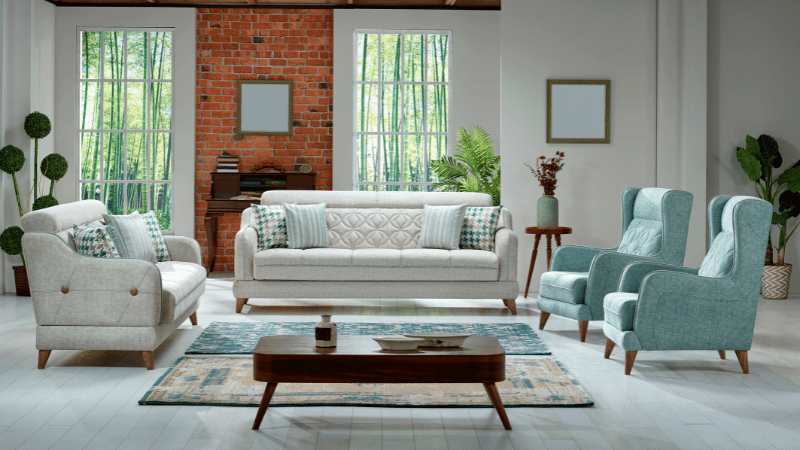Imagine stepping into a room where every piece of furniture feels like it was custom-made just for you—comfortably cushioned sofas, stylish yet functional tables, and seating that invites you to relax. The right furniture not only enhances the aesthetics of your space but also significantly contributes to your comfort and well-being. However, choosing furniture involves more than just picking out the latest trends; it requires careful consideration of materials, durability and potential off-gassing. Let’s explore how thoughtful furniture selection can create a truly comfortable living space.
The Significance of Furniture Choices
Furniture choices play a crucial role in determining the comfort and functionality of a living space. Here’s why selecting the right pieces is essential:
Comfort and Functionality
The primary purpose of furniture is to provide comfort and functionality. Well-chosen furniture should support your lifestyle needs—whether it’s a cozy couch for family movie nights, an ergonomic chair for home offices, or a sturdy dining table for entertaining guests. Comfort and practicality should go hand-in-hand, ensuring that each piece contributes positively to your daily activities.
Aesthetic Appeal
Furniture sets the tone for the overall aesthetic of your home. It can reflect your personal style, complement architectural features, and enhance the ambiance of a room. Thoughtfully selected furniture contributes to a cohesive and visually pleasing environment, making your space feel more inviting and harmonious.
Health and Well-being
Furniture materials and construction can impact your health and well-being. Some materials may contain harmful chemicals or contribute to indoor air pollution, affecting respiratory health, increasing risk of adverse health effects and overall comfort. Choosing furniture made from non-toxic materials and considering off-gassing factors can contribute to a healthier living environment.
Furniture Materials: What to Consider
When selecting furniture, consider the following factors related to materials and construction:
Natural vs. Synthetic Materials
Natural materials, such as wood, leather, and cotton, are often preferred for their durability and aesthetic appeal. They can also be less likely to off-gas harmful chemicals compared to some synthetic materials.
Natural Materials:
● Wood: Durable and timeless, with various finishes that can suit any decor style. Opt for sustainably sourced wood to ensure environmental responsibility.
● Leather: Luxurious and durable, though it requires regular maintenance to keep it looking its best.
● Cotton: Soft and breathable, but choose organic cotton to avoid exposure to pesticides and chemicals.
Synthetic materials, such as polyester, acrylic, and faux leather, can offer affordability and a range of design options. However, they may contain chemicals and off-gas volatile organic compounds (VOCs).
Synthetic Materials:
● Polyester: Often used for upholstery and is durable and stain-resistant. Look for low-VOC options to minimize off-gassing.
● Acrylic: Lightweight and versatile, but can be less breathable than natural fabrics.
● Faux Leather: An animal-friendly alternative to real leather, but ensure it’s free from harmful chemicals like phthalates.
Off-Gassing Considerations
Off-gassing refers to the release of volatile organic compounds (VOCs) from certain materials, which can contribute to indoor air pollution. Common sources include new furniture, carpets, and paints. To minimize off-gassing:
● Choose Low-VOC or No-VOC Products: Look for furniture labeled as low-VOC or no-VOC. These products are designed to release fewer harmful chemicals.
● Ventilate Your Space: Ensure good ventilation in your home, especially when introducing new furniture or other potential sources of VOCs. Open windows and use air purifiers to help reduce indoor air pollutants.
● Age of Furniture: The length of time furniture needs to off-gas can vary significantly depending on the materials used, the type of chemicals involved and the environment in which the furniture is placed. Here’s a general overview of what to expect:
Factors Affecting Off-Gassing Duration
- Solid Wood: Typically has minimal off-gassing, especially if it’s finished with natural oils or water-based stains. Off-gassing from solid wood furniture may last only a few days to a couple of weeks, primarily due to the finishes.
- Pressed Wood (MDF, Particleboard): These materials can off-gas formaldehyde and other chemicals for several months, with the highest emissions occurring in the first few weeks.
- Synthetic Upholstery and Foam: Synthetic materials like polyurethane foam can off-gas for weeks to months. The strongest odors usually dissipate within a few days to weeks, but low-level off-gassing may continue for months.
- Natural Upholstery and Latex: Natural materials like organic cotton, wool, and natural latex typically off-gas less and for shorter periods, often just a few days to a few weeks.
Non-Toxic Furniture
There are brands of non-toxic furniture that are designed to minimize or eliminate the use of harmful chemicals and synthetic materials, making it safer for your health and better for the environment.
Why Non-Toxic Furniture Matters
- Health Concerns
- Chemical Exposure: Many conventional furniture items are made with materials and finishes that can release harmful chemicals into the air, such as formaldehyde, flame retardants, and volatile organic compounds (VOCs). These chemicals can contribute to poor indoor air quality and cause health issues such as allergies, asthma, headaches, and even long-term effects like hormone disruption or cancer.
- Respiratory Issues: Off-gassing from toxic materials can irritate the respiratory system, especially in individuals with asthma, allergies, or chemical sensitivities.
- Environmental Impact
- Sustainability: Non-toxic furniture often uses sustainably sourced materials like FSC-certified wood, which helps reduce deforestation and promotes environmentally responsible practices.
- Eco-Friendly Production: Non-toxic furniture typically involves eco-friendly manufacturing processes that minimize waste and reduce the use of harmful chemicals, leading to a lower environmental footprint.
- Safety for Vulnerable Populations
- Children and Infants: Young children are particularly vulnerable to the effects of toxic chemicals, as their bodies are still developing and they spend a lot of time in close contact with furniture.
- Pets: Animals, like humans, can be affected by off-gassing chemicals, particularly if they spend a lot of time indoors.
Key Features of Non-Toxic Furniture
- Natural and Sustainable Materials
- Solid Wood: Opt for furniture made from solid wood like oak, maple, or walnut. Avoid particleboard or MDF (medium-density fiberboard), which often contain formaldehyde-based adhesives.
- Natural Finishes: Look for furniture finished with natural oils (like linseed or tung oil), waxes, or water-based paints and stains, which are low in VOCs and free from toxic chemicals.
- Organic Fabrics: For upholstered furniture, choose natural and organic materials like organic cotton, wool, linen, or hemp. These materials are less likely to be treated with pesticides, synthetic dyes, or chemical flame retardants.
- Natural Latex: Used in mattresses, cushions, and sofas, natural latex is made from the sap of rubber trees and is free from harmful chemicals found in synthetic foams.
- Avoiding Harmful Chemicals
- No Flame Retardants: Flame retardants, often used in furniture upholstery and foam, can off-gas harmful chemicals linked to various health issues. Non-toxic furniture avoids these additives.
- Low or Zero VOCs: VOCs are chemicals that easily evaporate into the air at room temperature, contributing to indoor air pollution. Non-toxic furniture uses low or zero-VOC finishes and adhesives.
- No Formaldehyde: This chemical, found in many adhesives and pressed woods, is a known carcinogen. Non-toxic furniture uses formaldehyde-free adhesives or alternatives like soy-based glues.
- Certifications to Look For
- Greenguard Gold: This certification ensures that the furniture has low chemical emissions and is safe for indoor air quality.
- FSC (Forest Stewardship Council): This certification guarantees that the wood used comes from responsibly managed forests.
- GOTS (Global Organic Textile Standard): This certification applies to textiles and ensures that they are organic and free from harmful chemicals.
- OEKO-TEX Standard 100: This standard tests for harmful substances in textiles, ensuring that they are safe for human health.
Brands Known for Non-Toxic Furniture
- Medley Home: Offers customizable, non-toxic furniture made from solid wood, natural latex, and organic fabrics.
- Avocado: Known for its non-toxic mattresses, Avocado also produces eco-friendly, non-toxic furniture made with sustainable materials.
- Vermont Woods Studios: Specializes in solid wood furniture crafted in the USA with non-toxic finishes and sustainably sourced materials.
- Savvy Rest: Provides a range of non-toxic, organic furniture, including sofas and platform beds, made from natural materials like organic cotton and wool.
- Cisco Home: Offers eco-friendly furniture with a focus on sustainable materials, non-toxic finishes, and responsible manufacturing practices.
Tips for Choosing Non-Toxic Furniture
- Research Materials: Ensure that the furniture is made from natural, sustainable materials like solid wood, natural latex, or organic fabrics.
- Check Certifications: Look for third-party certifications like Greenguard Gold, FSC, and GOTS to verify the safety and sustainability of the furniture.
- Inquire About Finishes: Ask about the type of finishes used on the furniture. Opt for those that are water-based or made from natural oils and waxes.
- Consider Upholstery: Choose upholstery materials that are organic and free from chemical treatments like flame retardants or synthetic dyes.
Tips for Creating a Comfortable Living Space
Creating a comfortable and welcoming living space involves more than just selecting the right furniture; it also includes considering layout, functionality, and personal preferences. Here are some tips to help you make thoughtful furniture choices:
Consider Your Lifestyle
Think about how you use your living space. If you entertain frequently, opt for durable, easy-to-clean fabrics and ample seating. For a home office, choose ergonomic furniture that supports good posture and productivity.
Prioritize Comfort
Test furniture for comfort before purchasing. Sit on sofas and chairs, lie down on beds, and evaluate the firmness and support of cushions. Comfort should be a priority, especially for frequently used pieces.
Balance Aesthetics and Practicality
Choose furniture that complements your decor style while also serving practical purposes. Invest in versatile pieces that can adapt to different uses and spaces, and consider multi-functional furniture like storage ottomans or extendable dining tables.
Quality and Durability
Invest in high-quality furniture that will stand the test of time. Look for well-constructed pieces with solid frames and durable materials. Quality furniture not only lasts longer but also maintains its appearance and functionality.
Personal Touches
Incorporate personal touches and elements that reflect your style and preferences. Add decorative accessories, such as throw pillows, rugs, and artwork, to enhance the overall look and feel of your space. Thoughtful furniture selection is key to creating a comfortable and inviting living space. By considering factors such as materials, off-gassing and functionality, you can ensure that your furniture choices enhance both the aesthetics and well-being of your home. Prioritize comfort, durability and health-friendly options to create a space that not only looks great but also supports a healthy and enjoyable living environment. Remember, your home is a reflection of your personal style and needs—make it a place where you and your guests feel truly at ease.


